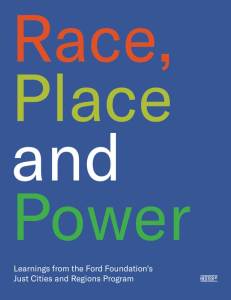Evaluation of Ford’s Just Cities and Regions Program
The Challenge
Housing insecurity is a challenge affecting the lives of far too many in the United States. After decades of work in the housing sector, we formalized the Just Cities and Regions (JCR) program in 2015 amidst a moment of growing racial and income inequality, increasing housing insecurity, and an accelerating climate crisis with disparate impacts. The strategy shifted from one based in 10 metro regions to one that aimed to bring about more systemic change across the country.
What We Did
Historically, Ford’s work in housing focused on fair housing and civil rights, eventually shifting to include investing in housing as individual assets and market interventions. JCR’s strategy centered race, place, and power to tackle spatial inequality within our towns, cities, and communities, as reflected in land, housing, and development.
JCR worked to integrate distinct dimensions necessary to winning change at scale by:
- Building community- and people-centered grassroots power through integrated civic engagement strategies
- Grounding those strategies in the leadership and vision of communities disproportionately impacted, anchored by an ecosystem of strong, networked social movement infrastructure
- Focusing on creating systems-level interventions rather than public policy reform or near-term “fixes”
- Supporting relationship-based and long-term co-governance by communities and those in public leadership roles
We sunset the JCR program at the end of 2021. In this reflection, we share our lessons throughout our history of investment.
What We Learned
1. Making upstream, often implicit, assumptions or decisions about the problem or its causes can have enormous downstream effects.
JCR’s focus on race, place, and power invited a broader vision of the underlying structural causes and a greater imagination of solutions (e.g., broadly available social housing). But advancing this vision requires unwiring the market-focused strains within the housing justice and community development field. At the same time, it requires shifting the emphasis back to strengthening the role of government and the public sector at all levels to protect, preserve, and produce more deeply affordable housing not controlled or distorted by the market.
2. Systemic, structural change at scale requires not only better public policy or more private dollars, but also a fundamental focus on communities of color most impacted by housing insecurity.
This, in turn, requires philanthropy to focus on civic engagement, power-building, and infrastructure-building from the ground up, rather than simply supporting policy innovation, advocacy, and service delivery through market-based systems.
3. Building durable and adequate power—narrative, economic, and civic—requires shifts to lead to long-term change.
Building this power requires time, a networked ecosystem, and a vision focused on co-governance rather than one focused on outside agitation or “grasstops” technocratic approaches. These shifts are the building blocks of success for issue-driven campaigns. Issue-first efforts may only secure one-off advancements when our goal is lasting change.
4. Centering racial justice and diverse communities as a path towards equity for all requires a deeper shift in practice.
Philanthropy must change the way it operates and should stop treating impacted communities as groups only to be consulted and engaged with superficially. This requires shifting to a model that prioritizes true community ownership over vision, strategy, action, and resources.
5. Philanthropy has considerable ability to convene stakeholders, direct the conversation, and shape the broader field.
For philanthropy to increase its impact, it should look beyond its grantmaking role and pay attention to the relational work and requirements. It’s crucial to advance change and avoid reinforcing problematic field dynamics.
6. Traditional metrics of success are important, but insufficient on their own. True power-building tactics can deliver the same advancements over longer periods of time.
Metrics, such as policy change, units built or preserved, people housed, changes in racial wealth, or dollars invested are important to measure impact. But those traditional measures are insufficient on their own, as they are often poor proxies to measure the depth of community power or the durability of change.
